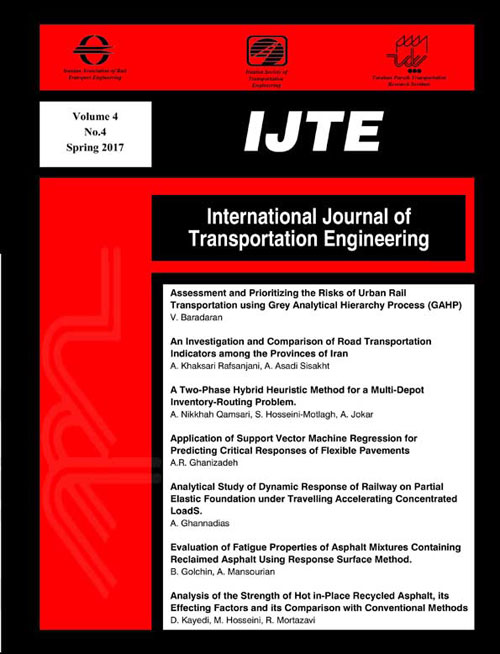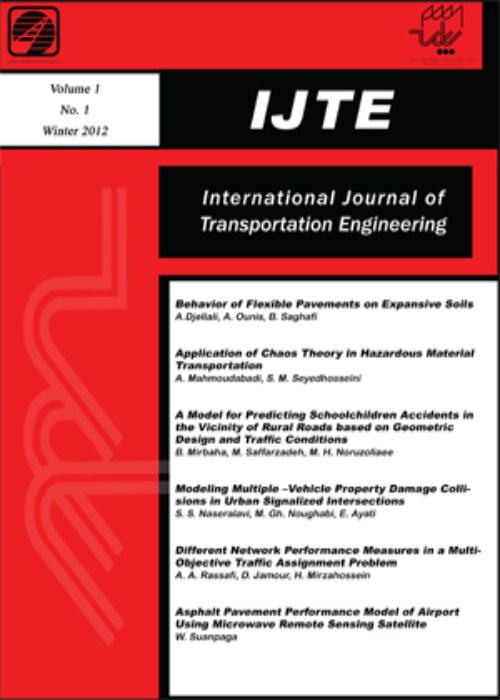فهرست مطالب

International Journal of Transportation Engineering
Volume:4 Issue: 4, Spring 2017
- تاریخ انتشار: 1395/11/30
- تعداد عناوین: 7
-
-
Pages 255-273Some incidents in urban railway systems affect the function of the subways company adversely and they could disorder the services. These events may inflict irreparable damage to passengers, employees and equipment. By recognizing the hazards existing in this type of transportation system and evaluating and prioritizing risks, we can perform appropriate actions to reduce the probability and severity of them. In this paper, thirteen risks of rail transport system in Tehran subway have been identified and nine evaluation criteria and sub criteria are specified. Analytical Hierarchy Process (AHP) approach based on the grey number scores (GAHP) has been developed in terms of complete uncertainty and incomplete information and risks are prioritized based on subway system experts opinion. The use of grey or interval numbers in AHP, in addition to more accurate assessment beside crisp numbers has lower computational complexity than fuzzy numbers. To calculate local and global weights for pairwise comparison matrices, a non linear and two linear optimization models are used. Injuring the passengers because of closing the doors of train is the important risk in Tehran subway system.Keywords: risk assessment, Multi Attribute Decision Making (MADM), Grey Analytical Hierarchy Process (GAHP), Grey Number, Subway transportation system
-
Pages 275-286Transportation is by people and for them. It is a process of providing mobility and accessibility for people both as passengers and as consumers of the goods. Therefore it is true when today there is an emphasis on the considering transportation the most influential development in every society. Regional development cannot properly be happened without enough transportation infrastructure and quality services both for passenger and freight.
Socio-economic impacts of transportation are amongst the most important issues in transportation planning and appropriate transportation planning is the key to sound regional development. One of the major planning issues is the transportation equality. Inequality of transportation, itself leads to many other inequalities and it is highly essential to consider that in the plans and policies regarding transportation in the country.
The main purpose of the present paper is to investigate and make a comparison of road transport indicators among the provinces of Iran. For this purpose, the relative level of transport development in different provinces was determined using taxonomy method. Nine indicators provided by Road Maintenance and Transportation Organization were used to carry out analyses. The data were analyzed and described by utilizing from SPSS and GIS Soft wares.
The outcomes indicate relative favorable development status in the region consisted of Tehran, Alborz and Qom provinces and unfavorable development of transportation status, especially in the Southeast region. In fact it was revealed that there is a Vertical inequality status of transportation in Iran.Keywords: Transportation, justice, Equality, Vertical inequality, Relative level of development -
Pages 287-304The inventory routing problem (IRP) arises in the context of vendor-managed systems. This problem addresses jointly solving an inventory management problem and a vehicle routing problem. In this paper, we consider a multi-depot multi-vehicle inventory routing problem in which suppliers produce one type of product to be delivered to customers during a finite time horizon. We propose a two-phase hybrid heuristic method based on variable neighborhood search (VNS) and the simulated annealing (SA) algorithm to solve the problem. In the first phase, the initial solution is generated, then the solution is improved iteratively in the second phase. The solutions are then compared with and without using the local search procedures. Computational results show the effectiveness of the proposed algorithm.
The inventory routing problem (IRP) arises in the context of vendor-managed systems. This problem addresses jointly solving an inventory management problem and a vehicle routing problem. In this paper, we consider a multi-depot multi-vehicle inventory routing problem in which suppliers produce one type of product to be delivered to customers during a finite time horizon.Keywords: Inventory-routing problem, Variable neighborhood search, Two-phase heuristic -
Pages 305-315This paper aims to assess the application of Support Vector Machine (SVM) regression in order to analysis flexible pavements. To this end, 10000 Four-layer flexible pavement sections consisted of asphalt concrete layer, granular base layer, granular subbase layer, and subgrade soil were analyzed under the effect of standard axle loading using multi-layered elastic theory and pavement critical responses including maximum tensile strain at the bottom of asphalt layer and maximum compressive strain at the top of subgrade soil were calculated. Then the support vector machine regression was used to predict these two critical responses. Results of this study show that the SVM can be used as a reliable tool to predict critical responses of flexible pavements. Analysis of flexible pavements using SVM needs less computing time and the SVM can be used as a quick tool for predicting fatigue and rutting lives of different pavement sections in comparison with multi-layer elastic theory and finite element method.Keywords: pavement analysis, support vector machine, critical responses, standard axle load
-
Pages 317-334The dynamic response of the railway under accelerated moving load using Dynamic Green Function is presented in this paper. For this purpose, an exact and direct modeling technique is introduced for the railway modeling as the damped Euler-Bernoulli beam on the partial Winkler foundation with arbitrary boundary conditions subjected to the moving load. The effects of the elastic coefficient of Winkler foundation, as well as velocity and accelerate of the moving load are assessed. The results are shown that the maximum deflection depends on the increasing or decreasing acceleration of the moving load. On the other hands, it does not occur at the central point of the beam for all acceleration values. Based on the results, the acceleration value of load dominantly defines the dynamic deflection shape of the Euler-Bernoulli beam. Some numerical examples are shown to demonstrate the simplicity and efficiency of the Dynamic Green Function in the new formulation, in this paper.Keywords: Damped Euler-Bernoulli beam, Dynamic Green Function, moving load, boundary conditions
-
Pages 335-350This paper presents the effects of different amounts of reclaimed asphalt on fatigue life of asphalt mixtures. Central composite method was used to design of experiments based on response surface method (RSM). Binder type (Pen 60/70 and Pen 85/100), reclaimed asphalt pavement (RAP) content (25, 50 and 75%) and loading strain (150, 250 and 350 micro strain) were selected as independent variables, while 50% of initial stiffness, fatigue life and final stiffness of asphalt mixtures were chosen as dependent variables. In this research study, fatigue properties of asphalt mixtures were measured by using the four-point bending beam. The RSM analyses showed that all independent variables were significant factors for prediction of 50% of initial stiffness and fatigue life. In addition, analysis of the tests results showed that the mixtures containing higher amount of RAP at lower strains, had higher final stiffness. Furthermore, the fatigue life of specimens increased, when the level of test strains decreased. Also at the lower level of loading strain, by increasing the RAP content, the fatigue life was not decreased.Keywords: Asphalt mixture, fatigue, Stiffness, RAP, RSM
-
Pages 351-358In recent decades, economic development and population growth in the world has led to the expansion of road networks. Therefore the use of optimum methods for repairing and maintenance of these roads is considered as an important value. Today one of the options in this regard, is the use of asphalt recycling technology. The present study which took place in the summer of 2015 in Iran, Lorestan province, is in line with this target with the goal to compare the recycling of asphalt with the common methods as well as the qualitative assessment of each method. In this study which was based on the analysis of asphalt samples from the Khorramabad-boroujerd route and samples from Arak-Qoms hot in-place recycling project, 9 laboratory samples were made using recycled asphalt pavements in accordance with the regulations of hot asphalt recycling of Iran. These samples were made using 80% recycled asphalt pavements which were collected from 3 different locations from lorestan province, as well as 20% raw and new materials. After conducting the quality control tests for asphalt on the 9 samples, one of the 9 samples that had higher technical specifications and was more in accordance with the Arak-Qoms recycling project mix design, was chosen as the optimal sample. The optimum samples test results were analyzed, compared and evaluated with the two projects mentioned above. The results showed that although both methods were in range with the minimum and maximum technical quality specifications, the recycling method had higher quality and technical specifications.Keywords: Hot in-place recycling(HIR), Recycled asphalt pavement(RAP), Asphalt stability, Asphalt air void


